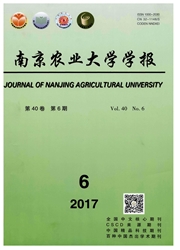

 中文摘要:
中文摘要:
[目的]为甜瓜抗蔓枯病聚合育种探索一种简单、快捷的选择方法,同时获得品质优良且高抗甜瓜蔓枯病的改良‘白皮脆’品种(系)。[方法]利用单一抗源PI140471(含抗病基因Gsb-1)与PI420145(含抗病基因Gsb-6)杂交,结合苗期蔓枯病菌A和A1梯度接种(5×105m L^-1、5×107m L^-1和5×109m L^-1)鉴定与SSR标记CMCT505及SCAR标记SGSB1800筛选,获得聚合2个抗蔓枯病基因Gsb-1和Gsb-6的聚合抗源471-145。以聚合抗源471-145为父本,品质优异的感病品种‘白皮脆’为母本进行杂交获得F1,选取含有聚合抗源且表现高抗的F1单株,再以‘白皮脆’为轮回亲本进行品种改良。[结果]SSR标记CMCT505可以在‘白皮脆’和PI140471上分别扩增出219和190 bp的特异性片段,SCAR标记SGSB1800可以在PI420145上扩增出1 800 bp的特异性片段,而聚合单株可以同时扩增出190和1 800 bp两条特异性片段。BC3F3群体筛选结果显示一些单株已经成功聚合了Gsb-1和Gsb-6两个抗病基因。单基因抗源PI140471和PI420145对不同菌株表现出选择性抗性且抗性水平低于聚合基因抗源。田间抗性观察显示,含有2个抗性基因的植株表现为高抗甜瓜蔓枯病,与分子标记检测结果一致。本课题组创建的分子标记CMCT505和SGSB1800对抗病基因Gsb-1和Gsb-6的选择具有较高的准确性,可以很好地应用于分子标记辅助选择甜瓜抗蔓枯病聚合育种。另外,抗性观察与果实品质测定表明改良‘白皮脆’品种(品系)高抗甜瓜蔓枯病且商品性优良。[结论]本研究初步建立了甜瓜抗蔓枯病聚合育种的分子标记辅助选择体系,为甜瓜抗蔓枯病聚合育种探索了一种简单、快捷的选择方法,同时也为甜瓜优质、抗病和高产育种提供新的遗传资源。
 英文摘要:
英文摘要:
[ Objectives] The aim of this study is to provide a rapid selection method for gummy stem blight resistance in melon pyramiding breeding and improve the resistance of ‘Baipicui'. [ Methods ] Single resistance source PI140471 and PI420145 were used as the donor parents with the gummy stem blight resistance genes Gsb-1 and Gsb-6, respectively. Commercial melon cultivar ‘ Baipicui' was used as the receipt parent to cross and backcross with the donor parents. Marker-assisted selection (MAS) and gradient spores vaccination identification( 5×105m L^-1and 5×107m L^-1 )were used in each backcross and self-cross progeny. In the first place,polymerization resistance source 471-145 was used as the male parent to cross with' Baipicui' to get the hybrid Ft. Then, the' Baipicui' was used as the female parent to cross and backcross with the Ft individuals which were resistant to gummy stem blight highly and contain two resistant genes. [ Results ] The results showed that the polymorphism of molecular markers were different among the parents. The PCR amplification of SSR marker CMCT505 could augment two specific fragments of 219 and 190 bp in susceptible melon cultivar ' Baipicui' and single resistance source PI140471, respectively. A 1 800 bp specific fragment was obtained with SCAR marker SGSBls00 in resistance source PI420145. The polymerization individuals could be amplified to produce both fragments( 190 and 1 800 bp)by CMCT505 and SGSBts00. From different kinds of molecular markers' detection results to the BC3F3 generation, it could be found that some individuals had two resistance genes (Gsb-1 and Gsb-6), while few individuals had one resistance gene. The single resistance source PI140471 and PI420145 showed lower resistance than polymerization individuals and selectively resistant to the different gummy stem blight biological strains(A and A~ ). The performance of each plant in the field estimated that all of the individuals containing two resistance genes were resistant to me
 同期刊论文项目
同期刊论文项目
 同项目期刊论文
同项目期刊论文
 Single-copy gene-based chromosome painting in cucumber and its application for chromosome rearrangem
Single-copy gene-based chromosome painting in cucumber and its application for chromosome rearrangem Genetic mapping of gummy stem blight (Didymella bryoniae) resistance genes inCucumis sativus - hystr
Genetic mapping of gummy stem blight (Didymella bryoniae) resistance genes inCucumis sativus - hystr 期刊信息
期刊信息
